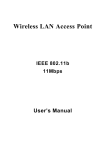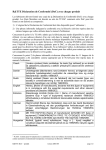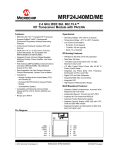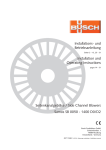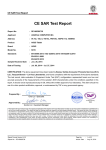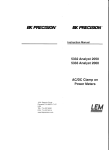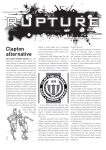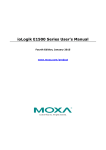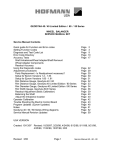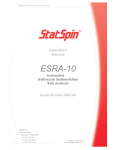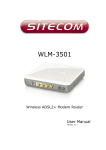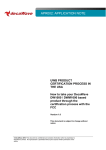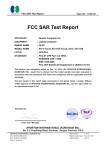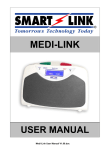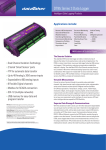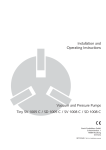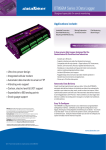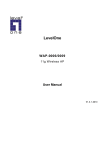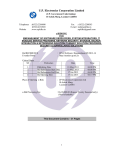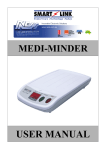Download Global Approvals for High Tech Products – UL Goes Wireless
Transcript
Global Wireless Device Approvals & Certification Overview Tony Henriques – Principal Engineer Inspection Body, Global Approvals, WiSE EULA © 2011 Underwriters Laboratories Inc. Topics 1. About UL WiSE 2. European Market Access / R&TTE Directive Overview 3. United States & Canadian Certification Overview 4. Global Approvals: International Market Regulatory Requirements Focussed around wireless devices! UL WiSE Who are we? TO HELP MAKE THE WORLD SAFER IN THE PLACES WHERE PEOPLE LIVE AND WORK World’s leading electrical safety testing and certification company • 6,900 employees Leading safety brand • 20 billion UL Marks on products • 100,000 products tested annually • World #1 for FCC Grant issuance Worldwide presence • 66,150 customers in 100 countries 4 • 68 labs and certification facilities4 across the world Underwriters Laboratories product safety environment • product safety • market access • regulations • claims validation • sustainability • standards life safety & security building materials power & controls energy high tech university • training & education • technical expertise • personal certification appliances/HVAC lighting verification • security, wireless, interoperability, EMC • energy efficiency • performance chemicals wire & cable medical life & health sciences • human safety • product safety food & water 55 What is WiSE? Wireless EMC WiSE Security & Payments Interoperability UL Verification Services: WiSE Locations 5 sites in the US 2 sites in the UK 1 site in China 4 sites in Japan 1 site in Italy 1 site in India 7 Global Approvals Regulatory Requirements Each region is different, but all based on similar themes: - Electromagnetic Compatibility (EMC) - Radio Performance - Safety (including Human RF Exposure) • and having suitable documented evidence of compliance In Europe these requirements are directly related to the European Union Directives and the Articles within them that must be conformed to in order to demonstrate compliance. Knowing the environment for use of the product is essential to understand the applicable requirements. European Market Access / The R&TTE Directive What is CE Marking? • Legal requirement for all electrical products sold in Europe • The CE marking on a product is a sign that the product complies with ALL new approach directives which apply to it, and are in force at the time of its supply • It is a sign to the authorities to allow the free circulation of compliant goods in the European Community • For most radio transmitter products, this means complying with the R&TTE Directive • Remember, you must meet the requirements of ALL applicable Directives • EU Directives include (as example): • • • • • EMC R&TTE (Wireless) Automotive Medical Low Voltage (electrical safety) What it is not! • A mark of quality • A mark which confirms that a product complies with a standard • An “approval” mark • A mark of origin Introduction to the R&TTE Directive… 13 • Radio and Telecommunications Terminal Equipment (R&TTE) Directive • Otherwise known as 1999/5/EC • A self-declaration approvals process for intentionally transmitting devices • Adopted 7th April 1999 • Implemented 8th April 2000 • Transition period ended 7th April 2001 Scope of the R&TTE Directive… 14 “The R&TTE Directive establishes a regulatory framework for placing on the market, free movement and putting into service of radio equipment and telecommunications terminal equipment (R&TTE) in the Community. A number of types of equipment are exempted from the Directive: equipment exclusively used for non-civil purposes and equipment covered by other Community instruments.” R&TTE Directive – Benefits for manufacturers… 15 • Removed National provisions – only test once for Europe • Time to market reduced • Assessment costs reduced, no “in-country” type approval • No compulsory third party testing • New technologies are not inhibited R&TTE Directive Overview • Who is responsible? • The Essential Requirements • Conformity assessment procedures Who Is Responsible? “The manufacturer, his authorised representative within the community or the person responsible for placing the apparatus on the market. Where neither the manufacturer nor his authorised representative is established within the community, the obligation to keep the technical documentation available is the responsibility of the person who places the product on the community market place.” Essential Requirements • Article 3.1(a) Safety (LVD, acoustic shock and EMF [Maximum Permissible Exposure or Specific Absorption Rate]) • Article 3.1(b) EMC • Article 3.2 Radio Article 3.1(a) Safety The protection of the health and the safety of the user and any other person, including the objectives with respect to safety requirements contained in Directive [was 73/23/EEC now 2006/95/EC), but with no voltage limit applying MPE / SAR requirements are covered by this Article Acoustic shock requirements are covered by this Article Article 3.1(b) EMC The protection requirements with respect to Electromagnetic Compatibility, this can refer to standards listed for the EMC Directive, if applicable (normally applied for telecommunications terminal equipment [TTE]) Article 3.2 Radio Radio equipment shall be so constructed that it effectively uses the spectrum allocated to terrestrial/space radio communication and orbital resources so as to avoid harmful interference Applicability of Conformity Assessment Procedures At the choice of the manufacturer, compliance of the apparatus with the essential requirements identified in Article 3(1)(a) and (b) may be demonstrated using the procedures specified in LVD Directive and EMC Directive respectively, where the apparatus is within the scope of those Directives For non-wireless products (TTE) • Annex II ( IV or V) For wireless products using harmonised standards • Annex III, IV or V For wireless products not using or only partially using harmonised standards • Annex IV or V Applicability of Conformity Assessment Procedures For wireless products using harmonised standards: • Harmonised standards as listed in the Official Journal of Europe Union (OJEU), they are not simply standards with the words “Harmonised” on the front page. • The current OJEU harmonised standards list can be found at: - http://ec.europa.eu/enterprise/policies/europeanstandards/documents/harmonised-standards-legislation/listreferences/rtte/index_en.htm For wireless products not using or only partially using harmonised standards: • Require a Notified Body “Essential test suite” and/or a Notified Body Opinion. Routes to Compliance 25 Routes to Compliance… R&TTE Directive Routes to Compliance Standards Route Technical Construction File (TCF) Route Produce Declaration of Conformity (DoC) CE Mark Full Quality Assurance Route Routes to Compliance… 26 • Annex III – Standards Route • Annex IV – Technical Construction File Route • Annex V – Full quality assurance route Annex III – Standards route… 27 • Harmonised standards are identified that cover all essential requirements: Radio EMC Safety • Test the product against the standards • Produce Declaration of Conformity • Apply CE Mark and Alert Symbol if applicable R&TTE Official Journal (OJEU)… 28 Lists all harmonised standards that can be applied to cover essential requirement: Annex IV – Technical Construction File Route… 29 Where harmonised standards are not available: • A Notified Body must be used to determine the essential requirement test suites • Test the product against the defined test suites • Compile the Technical Construction File (TCF) • A Notified Body assesses the TCF and gives and opinion • If the Opinion is positive, produce a Declaration of Conformity • Apply CE, Alert Symbol if applicable and Notified Body number A manufacturer can disregard a Notified Body opinion! Annex IV – Technical Construction File Route… 30 Why chose this route? • No harmonised standards available • Assessment of a family range is required Annex V – Full Quality Assurance… 31 Full quality assurance is the procedure whereby the manufacturer ensures and declares that the products concerned satisfy the requirements of the Directive that apply to them using their own audited quality system. The quality system must ensure compliance of the products with the requirements of the Directive that apply to them. The Technical Construction File (TCF) The TCF In the “Directive”: • Article 2, Definitions, sub part (g) "technical construction file" means a file describing the apparatus and providing information and explanations as to how the applicable essential requirements have been implemented; • Annex II sub part 4 “The technical documentation must enable the conformity of the product with the essential requirements to be assessed. It must cover the design, manufacture and operation of the product, in particular: • a general description of the product, • conceptual design and manufacturing drawings and schemes of components, subassemblies, circuits, etc., • descriptions and explanations necessary for the understanding of said drawings and schemes and the operation of the product, • a list of the standards referred to in Article 5, applied in full or in part, and descriptions and explanations of the solutions adopted to meet the essential requirements of the Directive where such standards referred to in Article 5 have not been applied or do not exist, • results of design calculations made, examinations carried out, etc., • test reports.” The TCF In the “Directive”: Annex IV (Technical Construction File) This Annex consists of Annex III plus the following supplementary requirements: The technical documentation described in point 4 of Annex II and the declaration of conformity to specific radio test suites described in Annex III must form a technical construction file. And then there is the R&TTE CA guidance note: http://www.rtteca.com/TGN15Rev1.pdf The TCF – In Simple Terms • Requirements and obligations • Specific elements • The rationale • Unified documentation • Defining the product • The DoC (applying EN54014) • Variants (manufacturer’s declaration of similarity) • Test results Requirements And Obligations • The TCF must adequately describe the single product type, family or range that it covers • The TCF must contain sufficient evidence to demonstrate compliance for all product types, including variants within its scope • This can be in the form of test results, technical design justification or a combination of both Specific Elements • Product description • Technical design data relevant to the case for compliance • Test results • Declaration of similarity of variants • Technical rationale (the case for compliance) • Declaration of Conformity with the Directive [R&TTE includes LVD and EMC] • Description of Labelling (“CE" mark) Defining The Product • What it is and its intended use • Type or model number • Description of family variants and scope of features • Range of model numbers for family variants • Reference drawings, pictures or plans • User or installation manual Unified Documentation • Consistent numbering • Titles can be linked to the product • Issue of the document is correct to the tested product • Top level BOM identifies major components Test Results • Test samples to be properly identified as representative of product or family (not prototypes or “golden” sample) • Choice of worst case samples to cover other variants to be justified in rationale • Proper and appropriate test methodologies • Measurement uncertainties included or their absence justified • Actual measurement results not just summary statements (where appropriate - not just “pass / fail”) Variants (manufacturers’ declaration of similarity) • Define what the differences are • Why those differences do not effect compliance • Worst case and why The Rationale • Explains conformity assessment choice • Includes technical justification based on design for claiming compliance where measurement not used • Explains significance of intended use environment where this impacts on choice of test levels and limits • Justification for using non harmonised standards or test methods • Justifies choice of test samples The Declaration of Conformity (DoC) • EN54014 • Manufacturer’s name and address • State Applicable directive (s) • State Standards with either version number or year of publication • Identity of Responsible person • Signed by • Where is it used The Notified Body Opinion • Issued when compliance has been demonstrated by TCF • Not mandatory if you have followed Harmonised Standards as listed in the Official Journal of Europe (OJEU) • Often used where the TCF includes untested variants and/or a third party agreement of rationale • Often used by “module” manufacturers to maintain confidentiality • Evidence that case for compliance has been approved by independent third party “expert” • Demonstrates due diligence Maintaining Compliance Through The TCF • Via your company “document control” procedures • Review and acceptance (or not ) of design changes • Periodic audit and review • Management Systems (Typically ISO 9000 series) • Monitoring updates to Harmonised Standards (No “grandfathering”) Maintaining The TCF • If the product changes: • Update the TCF • Confirm, does the product need to be re-assessed? • If so, fully or partially retested? • Who keeps the TCF? • Who can look at the TCF? • How long do you have to keep the TCF? Maintaining The TCF • If the product changes: • Update the TCF • Confirm, does the product need to be re-assessed? • If so, fully or partially retested? • Who keeps the TCF? The manufacturer or his authorised representative established within Community • Who can look at the TCF? Market Surveillance Authorities of any Member State • How long do you have to keep the TCF? 10 years after the last date of manufacture of the product Useful Information Harmonised Frequency Bands… 49 Once a transmitting products has met the requirements of the R&TTE Directive Country Notifications may be required. There are a number of Harmonised Frequency bands that all EU members states have adopted, depending on the following: • The assigned frequency band • The product allocation The classification of radio equipment can be found at http://www.ero.dk/rtte Product Marking Requirements… 51 Labelling requirements: • CE mark • Equipment Class Identifier (Alert Symbol) • Notified Body number (if used) United States & Canadian Certification Overview North American/Canadian vs European Approvals North American/Canadian Approval Europe Approvals Type Approval process Self Declaration Focused on Radio Certification Focused on Radio, EMC and Safety Product must fit Rule Parts/Standards Search for Standards to match product Evaluates RF Exposure Evaluates RF Exposure Application in public domain Documentation held by manufacturer Modular approval Modular approval TCBs\CABs perform market surveillance Few EU Countries perform surveillance The Regulations North American approvals: • Governed by The Federal Communications Commission (FCC) Canadian approvals: • Governed by Industry Canada Both follow very similar approvals approaches but they are not the same. FCC & Industry Canada Approvals Certification is a mandatory process for radio products made by direct application or via: • Telecommunication Certification Body (TCB) for FCC, or • Conformity Assessment Bodies for Industry Canada Copy of the regulations can be found here… • FCC: http://transition.fcc.gov/oet/info/rules/ • Industry Canada: http://www.ic.gc.ca/eic/site/ceb-bhst.nsf/eng/h_tt00011.html Routes to FCC/IC Approval For FCC, there are three main routes: • Route 1 – Verification (non-wireless devices) • Route 2 – Declaration of Conformity Route (DoC) (non-wireless devices) • Route 3 – Certification (wireless devices) For Industry Canada, there a slightly wider range of standards for nonwireless devices but all wireless devices require type approval and issuance of a technical acceptance certificate FCC Verification & DoC Routes 1. Manufacturer finds an FCC approved test facility 2. Test the product 3. Get a test report 4. Hold the report on file 5. Apply the appropriate equipment label 6. Sell product in US For the DoC route, you also need to make available the DoC to the user. FCC Verification & DoC Routes FCC/IC Certification Route 1. 2. 3. 4. 5. Manufacturer finds an FCC/IC approved test facility Test the product Get a test report Customer supplies application documentation - ‘Exhibits’ TCB/CAB (or FCC/IC in case of Direct Application) performs a Administrative & Technical Review 6. If product is approved: • Exhibits are uploaded to the FCC/IC website • TCB/CAB (or FCC/IC) issues the approvals Grant / Technical Acceptance Certificate • Client can sell in North America / Canada If not approved, manufacturer can not sell the product!! FCC / IC Certification Routes Three main certification routes for wireless devices: • Full certification route • Full modular approval route • Limited modular approval Full Certification Route • The certification/approval of an end product • Full testing in accordance with the appropriate FCC Rule Parts or Industry Canada RSS Standards • FCC/TCB or IC/CAB applications and listing fees • Grant of certification issued Full Modular Approval Based on FCC Part 15 C 212, conditions on which modular approval can be granted are as follows: • The radio elements of the modular transmitter must have their own shielding • The modular transmitter must have buffered modulation/data inputs • The modular transmitter must have its own power supply regulation • The antenna must either be permanently attached or employ a “unique” antenna coupler • The modular transmitter must be tested in a stand-alone configuration Modular Approval Based on FCC Part 15 C 212, conditions on which modular approval can be granted are as follows: • The modular transmitter must be equipped with either a permanently affixed label or must be capable of electronically displaying its FCC identification number • The modular transmitter must comply with any specific rules or operating requirements that ordinarily apply to a complete transmitter and the manufacturer must provide adequate instructions along with the module to explain any such requirements • The modular transmitter must comply with any applicable RF exposure requirement in its final configuration Limited Modular Approval Approval of a modular transmitter that does not meet all the criteria defined in Part 15 C 212. • Full testing in accordance with the appropriate rule parts of the FCC regulations and full listing fees apply • All host units in which the module can be used must be listed on the Grant of Application. • May incur additional application and listing fees to cover additional host devices • If buying a pre-approved module the module manufacturer will own the FCC Grant that requires updating to include a new host product Application Process Upon completion of testing a submission must be made to the FCC/IC. A compliant product will be issued an FCC Grant of Certification / IC Technical Acceptance Certificate. Typical documentation required: • • • • • • • • • • • • • • • • Application for Equipment Authorisation Form Confidential Agreement Form Agency Letter FRN Number Grantee Code Test Report(s) RF Exposure Information (if applicable) Test Set Up Photographs (may be included in the test report) Operational Description External and Internal Product Photographs Tune Up Information User Manual Block Diagram Schematics Parts Lists/BOMs Label Information FCC Registration Number (FRN)… The FCC Registration Number (FRN), is a 10-digit number that is assigned to an entity registering with the FCC. The entity that you register will have a unique FRN that is used to identify each entity’s business dealings with the FCC. The FCC will use the FRN to determine if all of an entity’s fees have been paid. FCC Grantee Code Assigned by the FCC and is obtained online from the following FCC web site: https://fjallfoss.fcc.gov/oetcf/eas/forms/GranteeRegistration.cfm Important Note: There is a charge payable on line at the time of Grantee Registration. The fee required must be submitted and validated within 30 days of the issuance of the Grantee Code, or the code will be removed from the Commission’s records and a new Grantee Code will have to be obtained. FCC Labelling Requirements The FCC ID is a unique identifier that indicates an approved FCC product. It comprises of two parts: 1. The Grantee code • Assigned permanently by the FCC to a specific grantee, normally the manufacturer, and this is only valid for that party at that address. It comprises a unique combination of three letters and numbers. 2. The Equipment Product Code (EPC) • Assigned by the applicant, a minimum of 1 character and a maximum of 14 characters and must consist of only capital letters, Arabic numerals or combination thereof, the hyphen or dash (-).The model name subject to the above is normally used. EXAMPLE: FCC ID: XXX123ABC • Where XXX is Grantee Code & 123ABC is the Equipment Product Code FCC Labelling Requirements cont… Please be aware of a future forthcoming change from the FCC: They are running out of Grantee Code letters, so the following will be implemented regarding new Grantee Codes: • Grantee Code expanded from three to five characters • 1st character of five always a number • Product Code will be reduced to a maximum of 12 characters • Full FCC ID remains a maximum of 17 characters EXAMPLE: FCC ID: 1XXXX12345ABCDE Where 1XXXX is Grantee Code and 12345ABCDE is Equipment Product Code Industry Canada - Labelling Requirements The Industry Canada Certification Number format is: “IC: XXXXXX-YYYYYYYYYYY” • Where: - “XXXXXX” is the Company Number (CN) assigned by Industry Canada, made of at most 6 alphanumeric characters (A-Z, 0-9), including a letter at the end of the CN to distinguish between different company addresses. - “YYYYYYYYYYY” is the Unique Product Number (UPN) assigned by the applicant, made of at most 11 alphanumeric characters (A-Z, 0-9) In addition user manual text is required (as is for FCC) however some text must be translated into French. Industry Canada - Company Number • Similar to the FCC Grantee Code, the IC Company Number is unique to the company require product certification • It is assigned by Industry Canada • To obtain a new CN please send an email to: [email protected] Industry Canada - Additional Requirements • Canadian in-country representative capable of responding to enquiries and who can provide post-certification audit samples at no charge to Industry Canada • Covering letter explaining the type of certification services requested and a brief description of the radio equipment • RSP-100 Appendix A from – Application and Agreement for Certification Services • RSP-100 Appendix B from – test Report Cover Sheet • RSS-102 Appendix A – Technical Brief Cover Sheet and B – Declaration of RF Exposure Compliance (or C – Declaration of RF Exposure Compliance for Exemption from Routine Evaluation Limits ) forms • User manual regulatory statements in English and French • Model number must appear on label The Application Process - FCC FCC Website and Product Listings All listings are held in the public domain on the FCC OET website: The Application Process – Industry Canada IC Website and Product Listings All listings are held in the public domain on the REL listing website: Permissive Changes Making Changes To Certified Products Once a product is certified, how are product changes managed? The FCC process is called the “Permissive Change” route and three classes are available: • Class I Permissive Change • Class II Permissive Change • Class III Permissive Change Important Note: • These do not require a new application/filing • None of the class of changes shall result in a change in identification Making Changes To Certified Products… None of the classes of changes shall result in a change in identification, however... Changes to the basic frequency determining and stabilizing circuitry (including clock and data rates), frequency multiplication stages, basic modulator circuit or maximum power or field strength ratings will always require a new FCC ID and a new equipment authorisation application to the FCC. Making Changes To Certified Products Permissive Changes generally consider changes in the following product areas (taken from FCC guidance): • Antenna changes • Printed Circuit Board (PCB) • Hardware changes • Enclosure changes • Software changes • Miscellaneous changes 78 Class I Permissive Change (C1PC) Key Criteria • Modifications that do not degrade the radio performance characteristics of the product from those reported when certification was granted • Generally cosmetic or non-radio changes • No filing is required • A C1PC can only be made by the original FCC Grant holder (normally the manufacturer) Class II Permissive Change (C2PC) Key Criteria • Modifications that degrade the radio performance characteristics of the product from those reported when certification was granted but still meet the requirements of the applicable rules • A TCB/CAB must be consulted to determine what tests must be repeated • If the product continues to meet the requirements of the applicable rules the original FCC/IC application must updated with full details of the modifications supported by the new test results Class III Permissive Change (C3PC) Key Criteria • Software modifications of a software defined radio transmitter that changes the frequency range, modulation type or maximum output power from those reported when certification was granted but still meet the requirements of the applicable rules. • A TCB or FCC must be consulted to determine what tests must be repeated. • If the product continues to meet the requirements of the applicable rules the original FCC application must updated with full details of the modifications supported by the new test results. RF Radiation Exposure Evaluation in North America RF Radiation Exposure Evaluation… There are two exposure categories that will determine how an evaluation is to be processed: • Occupational/Controlled Exposure • General Population/Uncontrolled Exposure Confirming “Mobile" or “Portable" classification and “Occupational/Controlled” (as defined in FCC Rule Parts 2.1091 and 2.1093) or “General Population/Uncontrolled” conditions MUST be established in order to determine RF exposure evaluation method and limits to apply RF Radiation Exposure Evaluation… How do you evaluate RF Exposure for Mobile devices? • FCC Part 2.1091 covers Cellular Radiotelephone, Personal Communications, Satellite Communications, General Wireless Communications, Wireless Communications, Maritime and Specialized Mobile Radio devices • Must operate at 1.5 GHz or below and effective radiated power is 1.5 watts or more, or if they operate above 1.5 GHz and their ERP is 3 watts or more • Generally done by a Maximum Permissive Exposure (MPE) calculation RF Radiation Exposure Evaluation… How do you evaluate RF Exposure for Portable devices? • Specific Absorption Rate (SAR) testing RF Radiation Exposure Evaluation… For the purposes of RF exposure evaluations, products fall into one of these categories: Mobile Devices • A transmitting device designed to be used in other than fixed locations with a separation distance of at least 20 cm from the body of the user or nearby persons Portable Applications • A transmitting device designed to be used within 20 cm of the body of the user RF Radiation Exposure Evaluation – Industry Canada requirements Canadian RF requirements are very similar but not identical e.g. additional SAR evaluation requirements with regards to bystanders for laptop type computers with antenna built-in on display screens. Requirements are detailed in RSS-102 Radio Frequency (RF) Exposure Compliance of Radiocommunication Apparatus (All Frequency Bands). FCC KDB Publications SAR procedures are generally accepted and referenced within RSS-102 where applicable. Specific report cover sheets/declarations are required • Annex A RF Exposure Technical Brief Cover Sheet • Annex B Declaration of RF Exposure Compliance or • Annex B Declaration of RF Exposure Compliance for Exemption from Routine Evaluation Limits Role of TCBs & CABs Use of FCC TCBs & IC CABs Telecommunication Certification Body (TCBs) and Conformity Assessment Bodies (CABs) are organizations with the authority to issue Certifications for compliance with the respective regulations. The ‘Scope’ of authority is however limited based on the expertise of the TCB/CAB. The TCB/CAB authorization process: • Offers manufacturers more than one approval body to select from • Provide a faster turnaround than the FCC's direct authorisation process • Keeps cost low and processing times fast via competition with other TCBs TCB/CAB Restrictions TCBs / CABs are not permitted to: • Grant waivers or certify products where no FCC/IC regulations exist • Certifying products on the FCC TCB Exclusion List • Enforce FCC/IC rules • Grant transfer of control of certifications • Impose their own requirements TCB/CAB Activities… Key activities do include: • Review test and application data from manufacturers or test laboratories • Certify devices in accordance with FCC rules/ IC RSS standards and policies • Verifying FCC / IC labelling requirements, including the FCC ID /IC Number • Issue written FCC grants of certification / IC Technical Acceptance Certificates • Approve permissive changes • Perform post market audits of equipment they certify Certifications are defined by their TCB/CAB Scope of Authority Useful Information FCC Knowledge Base (KDB) • The formal mechanism for consulting with the FCC • An online enquiry system open to everyone via https://apps.fcc.gov/oetcf/kdb/index.cfm • Used for clarification of: - Applicability and interpretation of rule parts - Technical test requirements - General application of the regulations Important Note: Interpretation of the rules without consulting the FCC is NOT permitted. FCC Knowledge Base (KDB) cont… • KDB enquires and FCC replies are allocated KDB numbers • Searchable references in the FCC/KDB website • Some published and common KDB references: - KDB 628591 TCB Exclusion List - KDB 388624 Permit But Ask List - KDB 178919 Permissive Changes - KDB 784748 Labelling Guidance - KDB 616217 SAR Laptop Procedure - KDB 941225 D01 SAR 3G Test Procedures - KDB 996369 Module Certification Guide FCC Permit But Ask (PBA) • The FCC apply restrictions on processing FCC filing for certain technologies or operating situation • Application can be process via TCBs but only in agreement with the FCC first, hence “Permit But Ask” • The PBA process is available to test firms, manufacturers and responsible parties, as well as TCBs • Gives test labs and manufacturers the ability to consult with the FCC to ensure testing can proceed and confirm the test requirements • This should be done BEFORE testing commences Global Approvals: International Market Regulatory Requirements Existing & Required Approvals Think about the wider approvals requirements: • What has been achieved? • What needs to be achieved? Order of approvals requirement: • Approvals efficiency Vs commercial pressure Acceptance of existing approvals documentation: • Some countries accept CE / FCC test reports • Recognised accreditation via MRA In Country Testing Required? Mandatory In-Country Testing • E.g. China, Brazil, Taiwan Understand what testing is required? • Full type approval testing • Pre-testing prior to full type approval testing (China) • Functional performance testing (Malaysia) Product Configuration Requirements: • How should the equipment be configured for testing? • How many samples of each configuration? • What support equipment is required? For example, laptop, software etc • What are labs test equipment capabilities? Can they support the product? • Can simple, clear instructions be provided on operation of the product? Is a product import permit required? Application Submission Documentation required is typically similar to the European TCF: • Schematics • Parts list • Block diagram • Quality assurance information (e.g. IS 9001) • Example label • User manual • Local representative details • Application Form Clearly identify all key parts of the product i.e. radio circuitry Example Label The label needs to be of a specific format which may include: • The approval logo or approvals mark • A certification number • Model name • Brand • Key warning / compliance statements For some countries the label can not be completed until the final certificate has been issued! User Manual Could be specific user manual requirements, for example: • Translated into the local language • Must include key compliance or warning statements • Model names should be detailed in the EXACT same format as on the application form Local Representation It may be a requirement for a locally based representative to act on your behalf. This could be: • Your own regional office • An appointed local distributor • Requested by the lab/agent • Local representative are usually based in the country where certification is required • Usually there is an annual fee! The Application Form To avoid re-submission costs, pay careful attention to the country application form, including: • Applicant name • Contact address details • Model name – including any spacing between characters • Local representation details • Sign in the correct places by authorised personnel (the applicant and local representative where required) The Approvals Certificate The certificate will be issued after: • All testing has completed and reports are issued • All documentation has been collected • An application has been submitted • The authority is happy with the application The certification number will then be confirmed but: • Check how long it is valid for (for example 1, 3 or 5 years) • Know when and how it must be renewed • Know how long that renewal process will take Hints and Tips to Effective Global Approvals In summary: • Understand the process (documentation review or testing) • Make sure samples configured correctly • Know the capabilities of the test lab (can they test the product?) • Ensure the documentation is correct (user manual, label) • Get the application form correct (model names match user manual) • Know if a local rep is required • Know when to renew the application Also, watch out for: • National holidays, such as Chinese New Year • Language issues Examples Brazil Regulator is Agencia National de Telecomunicacoes (ANATEL) •IS09001 QA certificate in Portuguese or notarised original •Local testing is required (all requirements) •Specific requirements for SAR testing •Time limited approval certificates •Specific labelling is required •User Manual must be in Portuguese •Local representative is required •Typical project durations: 2 to 4 months People’s Republic Of China (PRC) Regulator for Wireless devices is State Radio Regulatory Commission (SRRC). •Local testing is required (all requirements) •Factory inspection / quality system in place •IS09001 QA certificate •Specific labelling is required •Import permit is required •Documentation in Chinese •Local representative is required •Time limited approval certificates: 1 to 5 years •Typical project durations: 3 months About Us WiSE Asia UL Japan 1-22-3 Megumigaoka Hiratsuka-shi, Kanagawa 259-1220 Japan TEL: +81.463.50.6400 FAX: +81.463.50.6401 35 Staff 108 Yokowa-cho Ise-shi, Mie 516-1106 Japan TEL: +81.596.39.1485 FAX: +81.596.39.0232 WiSE USA UL CCS – Fremont (Also known as: Compliance Certification Services) 47173 Benicia Street Fremont, CA 94538 TEL: 510-771-1000 FAX: 510-661-0888 32 Staff WiSE Europe RFI - Basingstoke Unit 3, Hoizons, Wade Road, Kingsland Business Park, Basingstoke, Hampshire, RG24 8AH TEL: +44 1256 312000 FAX: +44 1256 312001 35 Staff Radiated Measurements At Kingsland Park facility Semi-Anechoic Chamber 5m measurement distance Reflecting ground plane Measurements accepted by: Europe, North America, Japan, Australia and others Radiated Measurements - Continued At Kingsland Park facility 2 x Full-Anechoic Chamber 3m measurement distance “Free space”, no reflections Measurements accepted by: Europe, North America, Japan, Australia and others Radiated Measurements – Antenna (OTA) At Kingsland Park facility Satimo StarGate 24 system TRP, ERP, TIS, EIS Active and Passive measurements 3D radiation pattern outputs Measurements accepted by: CTIA and GCF schemes Conducted Measurements Conducted Specific Absorption Rate DASY5 SAR Measurement System Specific Absorption Rate (SAR) SAR testing places the wireless transmitting device next to a phantom that represents the specific part of the human body – head or torso: Measurement probe Phantom - right side of head Phantom – left side of head Specific Absorption Rate (SAR) The phantom is filled with a fluid that replicates the human body. The probe is precisely moved within the fluid. Fluid Specific Absorption Rate (SAR) The probe measures numerous points in the fluid to establish a 3D model of the heat dissipation. Model of heat pattern in fluid Electromagnetic Susceptibility (EMS) 2. Conducted Electromagnetic Susceptibility (EMS) 3. ESD Electromagnetic Susceptibility (EMS) 4. Surge “Any Questions?” THANK YOU!





























































































































